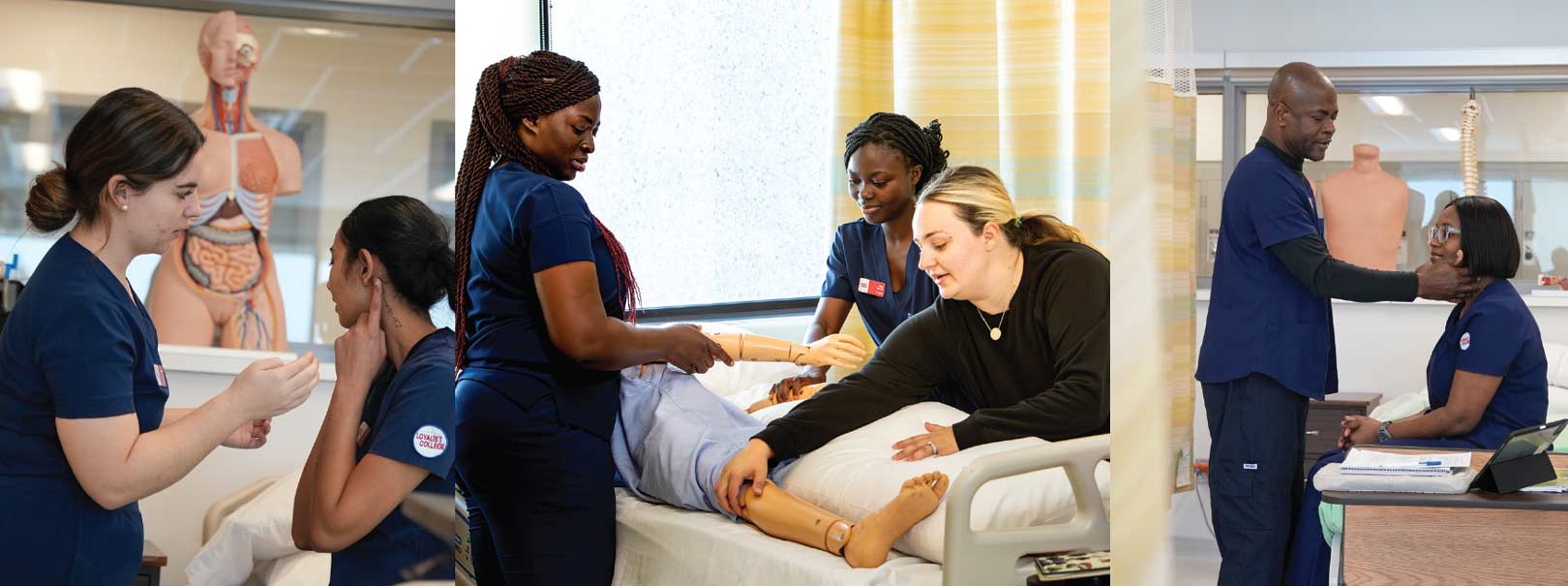

Left to right: Rebecca Short, RN, Intensive Care Nurse; Mustafa Alali, BSCN student at Loyalist College;

Loyalist nursing students practise on each other and on a lifelike mannequin that can mimic the behaviour of a real human.
Ever since the days of Florence Nightingale, “The Lady with the Lamp,” the image of nurses bringing light to dark times has been one of the strongest symbols in healthcare. Does the light still shine?
It’s Saturday evening. A nurse walks through the hospital doors into the Emergency Department to start a 12-hour shift. People stream past, pressing towards the triage desk. A boy in a hockey jersey lies on a gurney, a makeshift bandage around his head. A worried young mother sits in a corner holding a crying baby. What will happen on the floor tonight? the nurse wonders. Will there be enough staff? Will there be enough support if things get busy or tough?
Anyone who has been a patient, who knows or loves a patient, or who might someday become a patient (in other words, all of us) might be nervous at the prospect of becoming lost in the labyrinth of today’s healthcare system: staffing shortages, increased wait times, emergency room closures, massive surgical backlogs and fed-up patients – and on the front line of nearly everything is the largest segment of the healthcare cohort: the nursing staff.
The Globe and Mail’s André Picard recently described a healthcare system held together with “duct tape.” The reality is different; the system is held together not by duct tape, but by the dedication and tenacity of the healthcare practitioners themselves.
Nurses continue to work furiously to protect the patients they care for, but they report seeing a decline in their ability to do their jobs well. According to The State of Nursing in Ontario, July 2023, nearly 7 in 10 nurses surveyed do not feel they have the time and resources available to provide adequate care to their patients.
Premier Doug Ford has told an increasingly skeptical public that his government is “throwing everything but the kitchen sink” at the problem of medical staff shortages. But even if the government comes through, Ontario’s Financial Accountability Office says the system is projected to be short 33,000 nurses and personal support workers by 2028. In February the federal government announced a transfer of $3.1 billion to come to the aid of the Ontario healthcare system. Prime Minister Justin Trudeau said to hospital workers: “I know it’s been really tough over the past few years. You want to do good work but you’re stretched too thin…” It sounds as if he is talking to the nursing staff, but with 174 hospitals in Ontario, every one of them in need, the question is always whether the money will be used wisely enough to provide some actual improvement.
Is morale in the profession as bad as we hear it is? You’d think so, by looking at the stats. Not being able to do their best has been pushing nurses to the breaking point. According to a recent Nanos survey of 750 Ontario hospital workers, 41 percent say they “dread” coming to work each day.
Statistics, however, rarely show the whole picture. Behind every percentage point are the stories of administrators, medical personnel, technicians and support staff – those who work within the system in defiance of those statistics. They are the ones whose job it has become to fix what is broken.
And they are taking that job seriously. There are rays of hope across our region: programs, initiatives – many born within the hospitals themselves – to help ensure that the healthcare system’s most committed and valuable resources are equitably treated, properly compensated, and empowered to do their jobs. For their sake, it’s time to look beyond the dark headlines and learn what hospitals, educators and healthcare professionals are doing to shine light into the darkness.
TURNING THE CORNER
With nearly 38,000 visits to the Emergency Department in 2022/23 and thousands of other patients streaming in and out the doors, Cobourg’s Northumberland Hills Hospital (NHH) is a hive of activity. And like the 401 traffic that races nonstop by its windows, the hospital runs full tilt day and night. Keeping the doors open while providing a high standard of care is an ongoing challenge.
For Kate Zimmerman, the hospital’s Chief Nursing Executive and VP of Integrated Care, challenges are always present. “I think that’s the nature of the business,” says Kate. “We are consistently at capacity with our 137 beds, and sometimes over that. And the population here is both increasing and aging.” Right now, trained, experienced nurses are in short supply, and one cause stems from a crisis we’d all hoped was in the rearview mirror.
Most people would like to put the darkest years of Covid behind them, but for nursing its effects continue to be felt. During the pandemic, there was a large outflow of experienced, senior nurses from NHH, says Kate. The resulting gap put a strain on the remaining staff. Particularly hard hit were new nurse graduates coming into the system, who were left without mentors to help them through their early years.
Rebecca Short has been a registered nurse at NHH for nearly seven years. She says that things have definitely changed since she started her career. For one thing, patient ratios (available nurses per patient) are lower – Ontario’s are the worst in Canada and getting worse, according to a report released by the Canadian Institute for Health Information – so more is asked of everyone.
Kate, who is a registered nurse herself, agrees with many of her colleagues that nursing is not just a job, but a calling. “You don’t go into it for the money,” she says. One bright light in the compensation saga is that in February the Ontario Court of Appeal ruled that the provincial government’s Bill 124, which capped nurses’ salaries, was unconstitutional.
“I don’t think I could do some of the things I’ve done without having a passion for it. I fell in love with it because of the community and the support this hospital gives its people. During the pandemic it was always tough, but we adapted and we pushed through.” REBECCA SHORT
HELP WANTED
There is never enough money in healthcare, and expenditures are on the rise. One issue is the enormous amount of overtime hospitals have been paying. Kate Zimmerman points out that because of staff losses over past years, overtime is a fact of life. Another practice that has received mixed reviews is the use of nurses hired through an agency to fill the gaps in staffing. An agency could charge up to $160 per hour for an RN. Ontario’s auditor general estimates that the extra cost could have been as much as $160 million last year.
At the end of it all, however, there’s a human limit to the workload that any one nurse can carry.
For that reason, co-opting agency staff is vital “for the health and wellbeing of our nursing staff,” says Kate. The alternative is to discontinue services, and this has so far been avoided at NHH. The Intensive Care Unit is a good case in point. Rebecca Short points out that the unit can’t function without four staff members, so keeping up the complement is essential, wherever they come from. The bottom line, Kate adds, is that the hospital will sacrifice neither its obligation to staff nor the care owed to its patents if the situation can be mitigated by hiring nurses from agencies.
CULTURE SHOCK
Ontario Minister of Health Sylvia Jones has said that “more nurses than ever are graduating these days,” citing the addition of 15,000 new registered nurses in 2023. But brand-new workers in any profession do not become assets immediately – they need to learn the ropes. The challenge is to provide a mentally healthy working environment to counter the high-voltage culture shock new nurses experience in their first months on the floor. Without senior staff to guide novices through the first years, attrition is a constant worry.
To help deal with this situation and boost retention, NHH has implemented two specifically targeted programs to help support and retain new staff. One is the 12-week Clinical Internship, where newbies work alongside experienced nurses. Kate says they’ve had tremendous success with the program, which was launched in September 2022 with 24 nurses. Since then, “every single nurse who went through that program is still with us,” she says.
There is never enough money in healthcare, and expenditures are on the rise. One issue is the enormous amount of overtime hospitals have been paying.
After the Clinical Internship, nurses can participate in the Clinical Scholar program, which pairs an experienced front-line nurse with a new nurse. The mentorship ensures that nurses have the support they need to confidently transition into the profession. Last fall, Rebecca Short began to work with new hires in the Clinical Scholar program.
Both programs are government sponsored, so ongoing financial support is not guaranteed. Fingers are crossed.
Rebecca says that morale among staff is much better now, even though Covid still casts a long shadow. “You can’t go through what we went through without some low points,” she says.
“The community is incredibly supportive of the hospital,” adds Kate. “And we could not have turned the corner without the commitment and dedication of our staff.” “We support each other to get through a shift,” agrees Rebecca. “Things are positive.”
A TIME TO GROW
Campbellford Memorial Hospital (CMH) is a prime example of a small-town hospital with growing pains. Where NHH has 137 beds, CMH has a quarter that number, with overflow occurring often. Basically, the place is bursting at the seams, and those seams are showing their age. There are plans afoot (a new “Campus of Care” on the land donated by the Curle family, as reported in the Spring 2023 issue of Watershed), but relief may still be some time arriving. Meanwhile, the stretched-thin nursing staff does what they can with what they have. Heather Campbell is the Chief Nursing Executive and VP of Patient Care at CMH. With a job history including NHH as well as Quinte Health, she has intimate knowledge of the state of our region’s healthcare. She feels she has found her home at CMH – albeit one that keeps her hopping. “I never realized how many hats you wear when you work in a small hospital!” she says.
The nursing shortage is felt no less just because CMH is smaller and offers fewer services. One problem with a lower staff complement is that there is so little depth. “If our single respiratory therapist is away one day, we have no respiratory therapists,” says Heather. “It can be stressful when you don’t have all hands on deck; you go home feeling you didn’t do a good job that day.”
CMH was fortunate not to suffer from as much attrition during the pandemic as some hospitals did. “We have senior nurses that have been here for over 20 years,” Heather says, and many stayed on. At least one retiree even returns to work occasionally if needed. Like other hospitals, CMH has turned to agency nurses to fill the gaps, because not filling them could be catastrophic. “If we hadn’t had agency staff, we would have had to shut down our Emergency Department.”
A big challenge at CMH is recruitment and retention of staff. Smaller centres are not for everyone – there may not be the breadth of medical experiences to attract new nurses. Still, Heather finds there are nurses who find their way to Trent Hills, appreciative of the small-town atmosphere. Heather notes that the hospital was recently able to increase its Emergency Department nursing complement from three to four – a seemingly small number, but this has allowed them to reduce their costly dependency on the agencies.
To help retain staff, CMH is focusing their efforts on enhancing the learning experience for nurses straight out of school. “We need to be creative and innovative in some of our solutions,” says Heather. Unlike bigger hospitals, CMH lacks many in-house training facilities to get new recruits up to speed; so they struck deals with Loyalist College and Trent University to use their resources, which has provided invaluable training.
CMH is making life better for nurses by filling more staff vacancies and helping newcomers feel less overwhelmed and more like staying around. And everyone is looking forward to the new facilities, whenever they come.
BUILDING THE FUTURE
Prince Edward County Memorial Hospital (PECMH) in Picton is a little rural hospital with big plans. At the moment the facility – which lives under the Quinte Health umbrella along with its three sister facilities in Belleville, Trenton and North Hastings – has 23 in-patient beds plus an Emergency Department and offers multiple diagnostic services and minor surgery.
A decade-long redesign project is nearing its next stage. The project, supported by the Prince Edward County Memorial Hospital Foundation, includes a new state-of-the-art hospital. (Watershed reported on the Back the Build project in the Summer 2021 issue.) Shovels are expected to hit the ground this year, with the new facility opening in 2027.
Lina Rinaldi is Quinte Health’s Vice President and Chief Nursing Officer and says everyone is excited about the new hospital in Picton. “It’ll be a true legacy for the community,” she says.
“Nurses are the eyes and hands of the doctors. We are able to see the whole patient. I do experience times when I am overwhelmed with schoolwork, but this career is something I am passionate about. I see every challenge as an opportunity to grow.” MUSTAFA ALALI
Although they did not lose a lot of nurses during the pandemic, “staffing at the hospital has been tight at times,” says Lina, but PECMH has so far been able to do without using agency nurses to fill any gaps. As with CMH, some retirees are coming back to take shifts and relieve the stress. “Our staff is very loyal to the community.”
Tactically, coordination on the floor – including a discharge planning nurse, permanent charge nurses and a patient flow manager – helps support the medical staff and ease the stress levels.
The hospital is participating in government-sponsored recruitment and retention programs. Likely the new facility itself will be a recruitment bonus.
There is a robust offering of ongoing career development opportunities for new graduates as well as veterans. For novices, the hospital participates in the Clinical Scholar program – which Lina calls “at the elbow” support. In addition there are advanced practice programs available to help nurses upgrade their skills.
One popular route is for Registered Practical Nurses (RPNs) to leverage their credentials to make the move to an RN designation. At the moment two RPNs from PECMH are taking the “Bridge to RN” program at Loyalist College and both are completing a practicum in the hospital’s Emergency Department.
“A lot of that stopped during the pandemic,” says Lina, and everyone is glad to see the programs in motion again.
With the new hospital, career opportunities and strong support from both community and administration, the light at the end of the tunnel for PECMH nurses is shining a little brighter.
TOMORROW IS CALLING
Mustafa Alali is the nurse of tomorrow. A second-year student in Loyalist College’s four-year Bachelor of Science in Nursing (BScN) program, he exudes the optimism and enthusiasm of someone with their whole career ahead of them.
“Nurses are the eyes and hands of the doctors,” he says. “We are able to see the whole patient.”
Of course, there is stress that comes with his training, but he believes that nothing worthwhile comes too easily. “I do experience times when I am overwhelmed with schoolwork, but this career is something I am passionate about. I see every challenge as an opportunity to grow.”
Mustafa is aware of the obstacles ahead of him in the nursing world, but he feels he is being prepared to face them. More than just hoping to survive, he is already thinking of ways to improve things. “I want to be able to advocate for my fellow caregivers, to help them through times of stress and hopefully reduce the chances of burnout.”
Let’s hope the profession welcomes thousands like him.
In her role as Program Coordinator at Loyalist, Ashley Jackson brings both practical experience and academic knowledge to the table. She began her career as an RN but is currently working towards a PhD in nursing.
One of the aims of a nursing education at Loyalist College is to prepare students for what life will be like once they get into the world.
One of the aims of a nursing education at Loyalist is to prepare students for what life will be like once they get into the world, including all the complicated demands of healthcare today.
A major tool available to help prepare nurses for their first years in practice is the simulation lab, or sim lab, which consists of a realistic clinical room with life-like mannequins and medical equipment. “A sim lab gives students a place to practice their skills in a controlled environment, where they can make mistakes without harming a real patient,” says Ashley. Hands-on scenarios are created that mirror various clinical situations.
Years ago, nurses would begin their careers with a long, unofficial apprenticeship, says Ashley, where they would be taken under the wings of the more senior staff. Today that practice is all but gone; new nurses might find themselves thrown into leadership roles simply by virtue of being the only one on the floor who is an RN, regardless of how much work experience they have. Loyalist has implemented a series of leadership courses to help novice nurses deal with the intense interpersonal dynamics they will encounter once they’re on the job.
“It is still a rough ride for nurses,” says Ashley. “So much is asked of them, and they are expected to buckle down because of their passion for the profession.” A 2023 report by the Registered Nurses Association of Ontario echoes her thoughts: workplace support and reduced workload are the top two factors determining whether nurses decide to stay in the profession, ahead of compensation and career opportunities. At Loyalist, Ashley hopes she can help prepare the students for the experience so they start out with knowledge and confidence.
A 2023 report by the Registered Nurses Association of Ontario states that workplace support and reduced workload are the top two factors determining whether nurses decide to stay in the profession, ahead of compensation and career opportunities.
CANDLES IN THE RAIN?
It’s possible to believe the plans and strategies described here amount to lighting candles in the rain: implementing local measures when the problem is systemic. Or … it’s possible to believe that hospitals, medical practitioners and educators are doing everything they can to keep the flame alive as the government slowly comes onside with new programs and funding, because any light is better than darkness.
Meanwhile, people in need of care continue to file steadily into Emergency. For the nurse heading in to start another shift, it’s not a question of strategic planning or stable funding or kitchen sinks. It’s just a matter of getting the job done, walking the borderline between order and chaos, which remains as thin and keen as a scalpel blade.
Rebecca Short feels her calling as strongly as ever. “I don’t think I could do some of the things I’ve done without having a passion for it. I fell in love with it because of the community and the support this hospital gives its people. During the pandemic it was always tough, but we adapted and we pushed through.” And as other tough times arrive, Rebecca knows the nurses will meet them and push through again.
“Because that’s what we do.”
Story by:
Christopher Cameron


